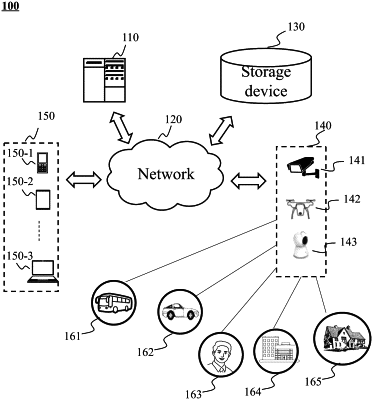| CPC G06V 20/58 (2022.01) [B60W 40/08 (2013.01); G06V 20/625 (2022.01); B60W 2420/403 (2013.01); B60W 2554/4049 (2020.02)] | 13 Claims |

|
1. A method for post-disaster contact in a smart city based on Internet of Things, which is applied to a management platform, comprising:
in response to the occurrence of a disaster event, obtaining event-related information from an object platform through a sensor network platform, wherein the event-related information comprises monitoring information, and the event-related information is obtained through a camera and/or a drone;
determining information and status of one or more related objects based on the event-related information;
determining one or more contact persons who need to be notified based on the information of the one or more related objects; and
sending notification information to the one or more contact persons by sending the notification information to a user platform through a service platform, wherein the notification information is received through a user terminal;
wherein the determining information of one or more related objects based on the event-related information includes:
obtaining a type of a target building based on a perception module; wherein the type of the target building comprises a residential building and a commercial building;
in response to the type of the target building being the residential building, obtaining family information of the residential building, and determining the information of the one or more related objects based on the family information;
in response to the type of the target building being the commercial building, obtaining corporate information of the commercial building, and determining the information of the one or more related objects based on a social security relationship corresponding to the corporate information; and
extracting image frames based on the monitoring information, and determining a type of a vehicle in a target area by performing target recognition on the image frames; wherein the type of the vehicle comprises a public vehicle and a private vehicle, and the target recognition is implemented based on a machine learning model;
in response to the type of the vehicle being the public vehicle, obtaining ticket checking information of passengers of the public vehicle, and determining the information of the one or more related objects based on the ticket checking information of the passengers; and
in response to the type of the vehicle being the private vehicle, determining a license plate number of the private vehicle by performing image recognition on the image frames, and determining the information of the one or more related objects based on the license plate number;
wherein the determining status of one or more related objects based on the event-related information includes:
determining the status of the one or more related objects using an evaluation model based on appearance data of the vehicle, the status of the one or more related objects including a result of vehicle integrity judgment and a state of the persons in the vehicle, the evaluation model being a machine learning model, the evaluation model including an integrity judgment layer and a status assessment layer, which is obtained by a training process including:
obtaining a plurality of training samples and labels;
training an initial integrity judgment layer and an initial status assessment layer, based on the plurality of training samples and the labels; and
obtaining the integrity judgment layer and the status assessment layer until a trained integrity judgment layer and a trained status assessment layer meeting a preset condition.
|